Different proteases and peptidases are present within chloroplasts and non-photosynthetic plastids to process precursor proteins and to degrade cleaved chloroplast transit peptides and damaged, misfolded, or otherwise unwanted proteins.
Collectively, these proteases and peptidases form a proteolysis network, with complementary activities and hierarchies, and build-in redundancies. The challenge is to determine the contributions of each peptidase (system) to this post-translational network. This will require an understanding of substrate recognition mechanisms, degrons, substrate and product size limitations, as well as the capacity and degradation kinetics of each protease. Extra-plastidial degradation pathways complement these intra-chloroplast proteases. Following a conceptual overview of this intra-plastid protease network, Dr. Van Wijk will provide an update on his search for substrates, substrate selection and regulation of the essential and abundant chloroplast Clp chaperone-protease system and its adaptors in Arabidopsis.
This search includes loss-of-function analysis, in vivo trapping, protein half-life measurements, N-terminomics, in vitro interactome analysis, combined with protein mass spectrometry. He will also highlight his recent proposal that UVR protein motifs play a regulatory role in substrate selection and Clp activity.
